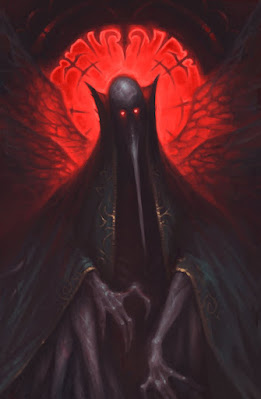Different Kinds of Vampires
So bats are the basis for your regular vampire, right? Well before Darkest Dungeon came along with their mosquito vampires, I was thinking along similar lines. (I will maintain to my dying breath that they reached into my mind while I slept and plucked this idea from me. I have punished the tulpas I conjured to protect the serene palace of my mind accordingly.)
So here are some vampires based upon different blood-feeding creatures in nature. Toying with vampire tropes as well as the unique facets of these creatures in nature.
By Diana Franco
Culexi:
Blood is the seat of memory, that which passes down not only your own memories but the memories of all your ancestors, the genetic memory of all ages, flowing hot and scarlet in voluptuous veins. By some trick of evolution one larger variety of mosquito, upon sucking the blood of a human being, gained all of their memories. The ages developed on this adaptation to hideous affect. The Culexi family of vampires are capable not only of of taking their prey's memories but they liquify their prey from the inside, leaving behind a pristine skin-suit that is fully operable by the insectoid form within.
Thus, Culexi do not have to deal with the messy and sometimes easily broken means of enchantment or hypnosis or blood addiction. They do not turn their prey. They drain them dry and wear their skins and memories as camouflage. If you are very unlucky, a one-night-stand with a too-eager partner may end up with you waking with a stomach ache and a weird red mark on your abdomen. Over time, the culexi larvae within, incubates and feeds using your blood and slowly liquifying organs until the creature simply takes over for your bones, muscles, and brain.
However, there are difficulties with the transfer of memories. Some Culexi, especially their young spawn, are overtaken by the emotion of their victims and even regret over killing them. Some Culexi fall in love with those that their victims were in love with, but coming clean to their victim's loved ones never works out.
Holothyri:
Ticks produce proteins known as evasins which deaden pain receptors and make it difficult for their prey to notice that they are even there. Since ancient days, one variety of tick has mastered this form of perceptual deadening. These huge ticks secret a neurotoxin that they inject with their first feeding upon a victim. This renders the victim incapable of perceiving the Holothyri. The Holothyri are also capable of issuing commands to the victims who are susceptible to suggestion of all kinds in this state. This is the key way of determining if someone has been a victim of a Holothyre, if they exhibit unusual pliancy to suggestion and commands.
The Holothyri do not need to hide or take on human form unless someone comes along who has not been fed upon. Left to their own devices, they will languidly feed on a population, rarely killing a victim in one feeding, unless it is time to produce young in which case someone will simply fall over dead in the middle of the village and the rest of the townsfolk will shake their heads. "Another one taken by the plague, such a shame."
Petromyres:
Blood is also symbolic of course. The shedding of blood is a sign of great effort and sacrifice, commitment, and even love. For did not Christ shed His blood for our drink as a sign of His love for us? Thus, the Petromyre does not really feed upon blood, but upon love. Tales are told of a young man who was out fishing when all others were in church. He found a nine-eyed little fish no bigger than his thumb. The fish bit his thumb gently, like a child suckling at their mother's breast. It was then that a strange affection for this creature washed over the young man's mind. Resolving not to lose this fish, he put in in a nearby well. Each day, he would return with living things for the fish to feed on and each day the creature grew longer and longer, and sometimes it would come up and the man would allow it to feed on his own blood, utterly content, utterly full of love for this creature.
The man grew older and had a family, but the lamprey was so large now, he put it back in the lake, but it always came when he called. He would feed whole cows to it. Then the "little fish" as he still called it seemed to want the loyal family dog. So he fed it to the beast. Then the "little fish seemed to ask with its nine-glittering eyes, "Who is your child truly? Is it not I? Who do you love best father?" The creature, now the size of a tree did not speak. Indeed it was just an animal for all its size, and yet the man heard and the man understood.
He gave his "little fish" everything, and once it towered over all the trees of the forest and its head was large as a hill, the man built a kingdom to feed the lamprey, then an empire all to offer endless blood, endless love to his "little fish" and all the "little fish's" squirming slithering children, the man's grandchildren, with such gentle bites, just like their mother.
The Bird Doctors:
Bad blood causes illness, so the doctors say with their long white beaked masks, as they apply the leeches to infections and the skin of the diseased. Everyone dreads the bird doctors. Their appearance means that surely sickness and death have come to the village. Yet, no one can fault them nor turn them away, why would you? They are here to help.
Sure they sometimes point to the mason or the butcher and declare them sick, though no one really thought they seemed so before, but if the doctor says so... The leeches are applied. The medicines are ingested. Most come back, albeit paler, although some do not survive the treatment.
Your father must have been very sick, and yet he never even coughed before the doctor began treating him. At his funeral, you could not help but clench your fists and think of that wretched doctor, think of his horrible mask. After a few drinks, you slammed open the door of his tower, red faced and sputtering, "Doctor! Doctor! You killed him! You killed, my..."
There, hunched over the open jar of engorged leeches is the bird doctor, shoveling the bulbous blood-suckers into a terrible gnashing beak, below shining, inhuman eyes.



What a fascinating little story piece! I've been considering the effects of more esoteric vampires in my own writing for some time now, and this only strengthens my resolve!
ReplyDeleteI feel you on the Darkest Dungeon part. It's too cool to be left alone!
It is a cool concept!
DeleteI like the Petromyres, taking that more symbolic approach. Also, Vampires are often thematically intertwined with romance and sexuality, so it makes sense. The Ticks was also a clever idea though. They're all awesome! For those interested, a long time ago I did a big table of alternative Vampires of my own :): https://weirdwonderfulworlds.blogspot.com/2018/09/vampires.html
ReplyDeleteWell with the Petromyre I guess it's described in a way that decouples love and romance or sexuality, but I think it would be interesting to explore that element of it as well.
DeleteThere is kind of a psycho-sexual thing going on there but, to me, it is more about perverted love in the parental or even Attachment way. It is misplaced love that eats and eats until nothing is left. The thing about the Petromyre that I alluded to but didn't actually say is that it isn't sentient. It really is just an animal that has mastered the ability to cause human affection either through some psychic or chemical means.
DeleteOh I like that touch, that adds a layer of grotesqueness to it. Like, it's existence almost challenges the notion of love or at least love as perceived through consciousness as some kind of spiritual or holy thing in the universe; even if you believe that to be true or it is true within the setting, its existence challenges that notion in an interesting way.
Delete